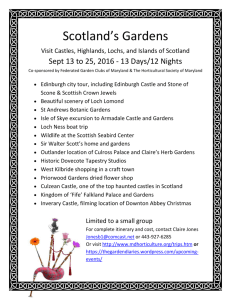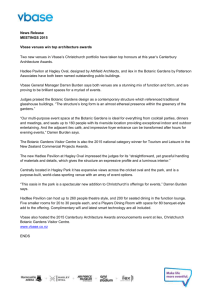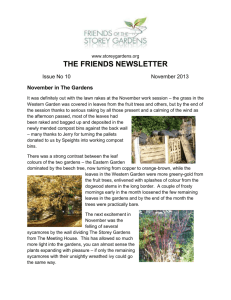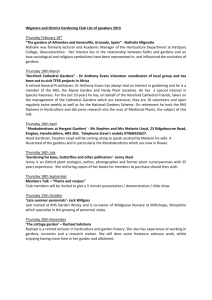MT COOT-THA - Brisbane City Council
advertisement
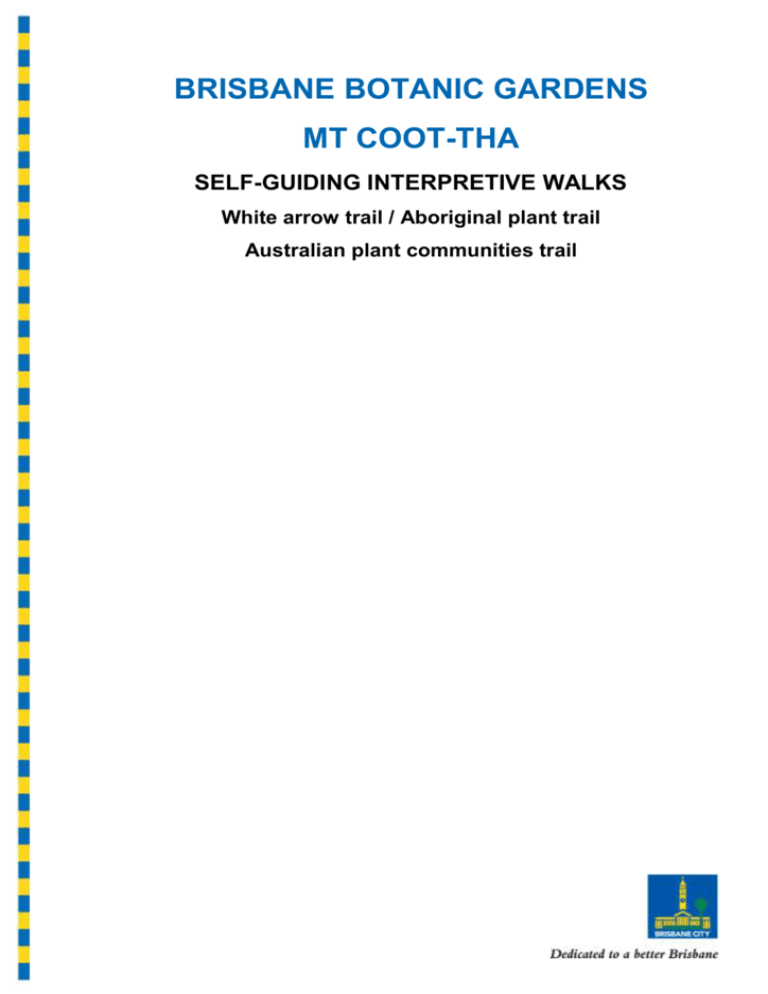
BRISBANE BOTANIC GARDENS MT COOT-THA SELF-GUIDING INTERPRETIVE WALKS White arrow trail / Aboriginal plant trail Australian plant communities trail Welcome to the Brisbane Botanic Gardens, Mt Coot-tha This brochure contains some general information on the major attractions in the gardens as well as suggestions for three different self-guiding walks. There are 52 hectares of living displays to explore. These are arranged in either themed beds or in geographical regions representing plants from around the world. Brisbane has two botanic gardens, one in the city and the other at Mt Coot-tha. Both are managed and maintained by Brisbane City Council. Brisbane Botanic Gardens Mt Coot-tha are recognized as Queensland’s premier subtropical botanic gardens. Founded in 1970, the 52 hectares of gardens feature more than 20,000 plants representing approximately 5000 species from around the world. Arid, tropical and temperate plants, both native and exotic, thrive outdoors in our uniquely-placed city, making these gardens a major tourist attraction. The City Botanic Gardens, Brisbane’s first botanic gardens, were established in 1855 on a riverside site set aside as a botanic reserve in 1828 when Brisbane was first settled. This land initially supplied food for the early penal colony. Later, as a botanic garden, it trialed crops and other plants from around the world, suitable for growing in the subtropical climate. These gardens are now regarded as the cradle of Queensland horticulture. Between 1870 and 1974, eight major floods swept through the City Botanic Gardens damaging valuable plant collections. Council looked at alternative flood-free sites for a new botanic gardens. An open woodland site seven kilometres from the city centre on the eastern slopes of Mt Coottha was chosen. Detailed planning and work began in 1970. In January 1976 the Brisbane Botanic Gardens, at the foot of Mt Cooth-tha, were opened to the public. Plant collections are now well established and include a fascinating series of distinctly different gardens arranged in thematic and geographical displays. The more recently developed Australian Plant Communities section of the gardens occupies more than half of the total area (27ha) giving a tremendous opportunity to view a large collection of Australian native plants. With these plant collections, educational and research programs, a reference and lending library, and the Queensland Herbarium on site, the gardens have much to offer the casual visitor, amateur or professional horticulturalist. Garden highlights Fragrant Plant and Herb Garden The wide pathways of this garden allow easy wheelchair access. The garden contains culinary, fragrant and medicinal herbs as well as flowers and aromatic foliage to delight the senses. You are invited to smell the blooms in season. Exotic Rainforest The Exotic Rainforest contains trees, shrubs and vines native to other countries, in deep valleys of high humidity created by cool streams and cascades. The exotic tropical trees provide protection for the flourishing display of ferns and flowering plants. Japanese Garden Originally installed around the Japanese Pavilion at World Expo ’88, the garden is recreated here as an enduring gift to the people of Brisbane from the people of Japan. This primarily evergreen garden provides a calm atmosphere that promotes contemplation and meditation. To achieve the desired effect in Brisbane’s subtropical climate, a combination of native and exotic plant species have been used. Bonsai House The Bonsai House was opened in November 1999. It is situated next to the Japanese Garden and is an inspiring addition to the gardens’ plant collections. There are approximately 300 plants, with as many as 100 on show at any one time, displaying a variety of bonsai styles and plants suitable for bonsai. Open weekdays 10am-12 noon and 1-3pm. Open weekends and public holidays 11am-3pm. Tropical Display Dome The Tropical Display Dome features a wide range of shrubs, climbers, epiphytes and small trees from the moist tropics. The humid atmosphere provides a microclimate close to the natural growing conditions of plants from tropical regions that cannot normally be grown in Brisbane. Open daily 9am to 4pm. Fern House The Fern House was opened in July 2002 and has more than 80 different species and varieties on display – from ferns that live on rocks and trees, or even in the water, to the magnificent giant fern, Angiopteris evecta. The walls and shade cloth provide the ideal growing conditions for these plants – protection from wind, relatively high humidity, some shade and moist soil. Open daily 9am to 4pm. Arid Region Plants and Cacti House Here the dry regions of Central America and Africa are represented by plants that adapt in similar ways to their respective harsh environments. Stem-succulent Euphorbia and Jatropha contrast with juicy-leaved Aloe, Kalanchoe, Lampranthus and similar forms. Together they combine to simulate the rugged beauty of life in a desert landscape. Temperate Garden The Temperate Garden, on the far side of the Lagoon, contains an extensive azalea and camellia collection, magnolias, deciduous trees and other temperate plants. The garden beds explode into a magnificent festival of colour every spring. Australian Rainforest The Australian Rainforest, to the right of the main entrance, is the oldest section of the gardens and is an excellent example of a lowland subtropical rainforest. A self-guiding Aboriginal Plant Trail helps visitors learn how traditional and contemporary Aboriginal communities used Australian rainforest plants for food, medicines, shelter, utensils and tools. Australian Plant Communities Plantings in this section of the gardens began in 1984. It occupies 27 hectares and features hundreds of Australian native plants arranged in natural communities and picturesquely landscaped around a large lake. An area dedicated to displaying a significant selection of Australian native palms, known as the Palm Grove, is particularly attractive. Lagoon and Bamboo Grove Planted late in the 19th century, the grove provides shade for picnickers as well as shade for the inhabitants of the lagoon. The lagoon area is teeming with wildlife including eastern water dragons and other reptiles, a variety of ducks and other birds, fish and insects. White Arrow Trail The White Arrow Trail has been prepared to introduce you to some of the highlights and plant varieties found here. At a leisurely pace you should complete the tour in 60 minutes. From the Information Centre look for a white arrow on the ground. Head towards the signpost directing you down to the Exotic Rainforest (in botanical terms ‘exotic’ means ‘not native, originally from overseas’). Use the White Arrow Trail map as a guide and keep a look-out on the ground for more white arrows. 1 Frangipani (Plumeria rubra) Frangipani flowers can vary from white with yellow centres to the deepest shades of rose and yellow. The tree’s ability to burst into leaf and flower, even when not in the ground has led to the frangipani being regarded as a symbol of immortality. 2 Sycamore fig (Ficus sycomorus) A native of the Middle East, this large, spreading tree with clusters of figs on little stalks forming on its trunk, is the sycamore of the Bible. Zacchaeus climbed one in Jericho to see Jesus (Luke 19:1). Cross the bridge and walk to your right to find: 3 Tower tree (Schizolobium parahyba) Reputed to be the fastest growing and the tallest tree in these gardens, it is also known as the yellow jacaranda or mexican fern tree. Its leaves resemble fern fronds and it is deciduous for a short period in spring. 4 Roxburgh fig (Ficus auriculata) This strikingly attractive fig tree has very large leaves and produces pear-shaped fruit in dense clusters all the way down its trunk and along older branches. It is cultivated for its ornamental appeal. 5 Cigar box cedar (Cedrela odorata) Although not a true cedar, the timber from this tree has a similar colour, grain, aroma and resistance to pests. It is used in archery bows, furniture and cigar boxes (said to impart flavour to cigars). 6 Hoop pine (Araucaria cunninghamii) This conifer mainly grows naturally in rainforests. One variety of this tree occurs in New South Wales and Queensland, while another grows in New Guinea. It is a valued softwood timber tree with distinctive golden-brown bark and narrow leaves that cluster along horizontal branches. 7 Tabebuia species Tabebuias make excellent feature trees and some species are regarded as the most outstanding flowering trees in the world. Covered with large heads of pink or yellow trumpet flowers at different times of the year, nine spectacular species grace these gardens. The bridge over the pond, on your left, straddles the main water supply pipe for Brisbane’s northern suburbs. The water in this pond is recycled (by pumps) to the creeks and waterfalls above. As you cross ‘the dragon bridge’, look over to the pond below and see how many eastern water dragons you can spot. 8 Floss silk tree (Chorisia speciosa) The large spikes on the trunk of this tree are usually the feature that attracts the most attention. However, in spring and autumn, the tree produces large heads of bright pink five-petalled flowers with white and brownish markings. You can now proceed directly to the Tropical Display Dome to experience plants of the moist tropics but a worthwhile diversion is to take the winding path down to the right that leads to the Japanese Garden. You will experience an added sense of peace and tranquility if you take the time to stroll through this appealing example of the mountain-pond-stream style of Japanese landscape architecture. 9 Lobster claw (Heliconia species) Grown for their stately banana-like habit (sometimes six metres tall), handsome foliage and superb waxy flowers, heliconias grow well in greenhouses, moist semi-shaded tropical and subtropical gardens. Leaving the Tropical Display Dome you now enter the desert-like landscape of the Arid Region Plants. Keep following the white arrows. 10 Pony tail plants (Nolina recurvata) Donated to these gardens, these 50-year-old plants are strikingly strange. They are native to Mexico and show many adaptations for frost-free desert and semi-desert regions – swollen trunks with thick corky bark and reduced fibrous leaves. 11 Euphorbia species Euphorbia species have a milky white sap in common which is toxic in most cases. Their form and habit, however, range from crumpled, spiky, cactus-like succulents, to the fairy white bracts of ‘snowflake’ and the large bright red bracts of poinsettia. 12 Baobab tree (Adansonia digitata) Related to the baobabs in Western Australia, this African species flowered for the first time in February 1995. Its trunk will develop a ‘swollen urn’ shape and, when leafless, the tree looks like it is growing upside down. Your final stop is the Cacti and Bromeliad House. Here you will see simulated forest and desertlike areas of tropical and subtropical America and Africa and the fascinating plants found in them. You can now either visit the cafe or exit to the car park. If time permits stroll back to the Information Centre via the Fragrant Plants and Herb Garden. White arrows will guide your way. Australian Plant Communities Trail This self-guiding trail takes you on a highlight tour of the newest section of the Gardens – 27 hectares of Australian native plants arranged in natural associations. Started in 1984, the plant communities on display include tropical and subtropical rainforests, open eucalypt forest, heathland and wetlands as found in the eastern part of Australia. The walk will take you about 60-90 minutes and will give a good overview of the area. Start from the Lookout car park and follow the road down past the Bunya Forest to the first path on your right. Here you will see a large map with an account of the development of this site. Turn left from the sign and walk down the path, then take the first path on the right. 1 Blue quandong (Elaeocarpus grandis) A very attractive tree with unusual edible fruits and sculptured seeds. Growing to 40 metres, the tree is easily recognised by the presence of scattered single red leaves throughout its foilage. Note the developing buttressed roots – a typical feature of rainforest trees. 2 Brush cherry (Syzygium australe) A wide range of lilly pilly species provide edible fruits. They are eaten raw when ripe and the taste varies from sweet to bitter sharp. They can also be made into jams. 3 Cycads Cycads are primitive seed-plants that grew in the dinosaur age. Preferring shady, well-drained places they have long, palm-like fronds. There are male and female plants. The female cones are larger and often bright orange. 4 Broad-leaved paperbark (Melaleuca quinquenervia) Melaleucas are an important part of wetlands, however, in South East Queensland more than half the paperbark forests were cleared between 1974 and 1989. Their thick, papery bark has many uses: roofing material, bandages, blankets, ‘disposable’ raincoats, slings for babies, food and water containers, and rings to cushion loads carried on the head. The aromatic leaves can be boiled and the liquid used to treat colds and the flowers can be soaked to extract nectar for a sweet drink. Pause for a moment on the viewing platform to look across the lake to the Totems. First exhibited at Expo ‘88, they are carved from hardwood, probably eucalypts. There’s a story that they are made from logs that were too crooked for use as telegraph poles. 5 Swamp banksia (Banksia robur) This sprawly shrub with large stiff leaves is found in coastal heathland. It produces enormous cylindrical flower heads that vary from bright lime or dark blue-green when young to brown and furry when mature. Note the other species of banksias in this area. They show the great variety in leaf shape, colour, flower heads and growth habit found in this quintessentially Australian plant. 6 Fox tail palm (Wodyetia bifurcata) This palm is classed as vulnerable in its natural habitat, the steep rocky outcrops in a limited region of the Cape Melville area. Discovered in the 1970s, it is now readily available in nurseries and its survival is assured in cultivation. 7 Pink euodia (Melicope elleryana) When this tree is in flower or fruit it attracts masses of birds, creating a magnificent open-air aviary. Butterflies are also attracted to the flowers. 8 Palm Grove When rainforests meet creeks and other waterways, palms abound. Note the solitaire palms (Ptychosperma elegans). Carpentaria palms (Carpentaria acuminata) have black lenticels (pores) on their trunks. Carpentarias occur naturally only in the Northern Territory. Alexandra palms (Archontophoenix alexandrae) are the palms with bulbous bases. The vertical scars on their trunks are growth abnormalities from unusual climatic conditions. After Palm Grove, take a sharp left up the hill... 9 Candle nut tree (Aleurites moluccana) A common tree in northern Queensland tropical rainforests, also found in the Pacific Islands. Its common name comes from the use of its large seeds as candles which contain sufficient oil to burn with a smoky flame. Young plants have lobed leaves whereas the leaves on more mature trees are diamond-shaped. 10 Red cedar (Toona ciliata) Renowned for wonderful timber and its rapid disappearance from forests with the coming of Europeans, red cedar is a large, deciduous tree native to Australia and Asia. 11 Lawyer vine (Calamus caryotoides) The barbs and spines are easily stripped off this climbing palm, leaving long flexible rope for treeclimbing supports, baskets and fish net frames. In South East Asia related species of palm, called rotan or rattan, provide raw material for the cane furniture industry. Lawyer vine is also called ‘wait-a-while’ because of the delay its barbs may cause to anyone entangled in it. 12 Hoop pine (Araucaria cunninghamii) Closely related to the bunya pine (Araucaria bidwillii), the hoop pine is a native conifer found in subtropical rainforests. Its timber is a quality softwood which features in many old Queensland homes. The twisted, coiled bark of this tree is ideal for use on sloping ground as mulch. We hope you’ve enjoyed your tour of our dynamic Australian Plant Communities section. We encourage you to come back at different times of the year to see different plants in flower and fruit. Aboriginal Plant Trail DANGER! Do not eat any plants. This information on traditional use of plants for food and medicine is informative only, NOT recommended. This self-guiding trail has been prepared to introduce you to some of the plants found in the gardens that were used by Aboriginal communities. Aboriginal people have used native plants for medicine, shelter, materials and food for tens-ofthousands of years reflecting detailed knowledge of the environment. Many plants require complex and elaborate processing and this knowledge has been passed down through the generations in legends, stories and practical demonstrations. Today there is a growing interest in traditional Aboriginal cultures, bush foods and traditional medicines. The Aboriginal Plant Trail takes you around the oldest section of the gardens, the Australian Rainforest, which was planted in 1974. There are many interpretive signs beside the path with more than one specimen of the plants highlighted in this brochure. The walk will take you about 30 minutes at an easy pace. 1 King orchid (Dendrobium speciosum) The swollen stems are beaten to a pulp to break up the fibre before cooking on hot stones. The starch can then be sucked out. The starch can also be used to fix paints. 2 Foam bark (Jagera pseudorhus) The inner bark contains saponins which can be used to poison both fresh water and marine fish. The saponins stop the uptake of oxygen over the gills but leaves their flesh edible. 3 Cluster fig (Ficus racemosa) Ripe cluster figs are edible, but the taste can vary from floury to sweet. Figs are unusual fruits because their flowers are internal and they are pollinated by wasps. Little native wasps can often be found inside these figs. Aborigines would hollow out the soft trunks of cluster figs to make canoes. They would also scrape off the inner bark and boil it in water to produce a liquid to treat diarrhoea. Pause for a moment on the bridge and look down the creek. Here you can see the layers of vegetation typical of an Australian subtropical rainforest: ferns on the forest floor, an understorey of young palms leading up to a canopy of tall trees. 4 Pepper vine (Piper novaehollandiae) The red fruits are edible and contain peppery seeds. The leaves were chewed to relieve sore gums. Colonial doctors used an extract to treat mucous discharges. 5 Candle nut tree (Aleurites moluccana) The large, hard-shelled seeds are poisonous when raw, but taste like macadamia nuts after being roasted. The nuts can be used as a fuel source as they contain sufficient oil to burn with a smoky flame, hence the name. Some Aboriginal communities used the tree sap and fruit skins to cure fungal infections on the skin. The dead tree was also valued as a source of edible grubs. 6 Brown pine (Podocarpus elatus) The fruit comes in two sections and it is the purpleblack fleshy stalk that can be eaten. It is high in vitamin C and has a sweet plum-like taste. It can be made into jams, jellies, tarts and condiments and is often served in bush tucka restaurants. 7 Small-leaved lilly pilly (Syzygium luehmannii) A wide range of lilly pilly species provide edilble fruits. They are eaten raw when ripe and the taste varies from sweet to sour-sharp. Some types were used for medicinal purposes including treatment of flu, colds, diarrhoea, aching ears, open wounds, swelling stomach pains and sore throats. 8 Spear tree (Macaranga tanarius) Bark from this fast-growing tree provides fibre for making nets and the light wood in the trunks was used by Indigenous people for making fishing spears. The large leaves can be wrapped around food for cooking in a fire. 9 Cabbage palm (Livistona australis) String bags, baskets, fishing nets and lines can be made from the fibre in young leaves. The leaves can also be used for roofing on shelters and early pioneers made them into hats. The terminal bud can be cooked as ‘palm cabbage’, but harvesting this delicacy kills the tree. 10 Mat-rush (Lomandra longifolia) The soft white bases of the new shoots are pleasant to eat and taste like raw green peas. The tough strap-like leaves can be woven into mats, baskets or used as tight-fitting bands. By beating and soaking the leaves, fibre can be extracted to make string for net bags. 11 Piccabeen (Archontophoenix cunninghamii) The large brown leaf sheaths make excellent ‘pikkis’ or carrying vessels for food, water or honey. The palm heart (the growing bud at the top of the tree) can be boiled or roasted in the ashes of a fire, but this results in the death of the tree. 12 Black bean (Castanospermum australe) The chestnut-like seeds are very poisonous when raw, but are made edible by a complicated process of pounding, roasting and soaking in running water for long periods. The resulting meal tastes like rice and was a staple food source for Brisbane Aborigines, who called it ‘mai’. To see more native plant species you can explore the Australian Plant Communities. Commenced in 1984 and covering 27 hectares, the plant communities include tropical and subtropical rainforests, wetlands, open eucalypt forest and heathland as found in the eastern part of Australia. Access Entry to the gardens’ car park is from Mt Coot-tha Road. Disabled parking is available and access for the frail or disabled is possible to most areas, but some facilities may require assistance. The Brisbane Mobility Map, available from the Administration Building, gives detailed access information. On weekdays, vehicles are permitted to drive through the gardens. The Brisbane Botanic Gardens are open every day between 8am and 5.30pm (closing 5pm April to August). Entry is free. Gates are opened to vehicle access at 8am on weekdays, and closed to vehicle access at 4pm and on weekends and public holidays. For more information about the gardens: call into the Administration Building situated near the main entrance to the gardens, open weekdays from 8am to 4pm visit www.brisbane.qld.gov.au/botanicgardens phone Council on (07) 3403 8888. Free guided tours 11am and 1pm Monday to Saturday (excluding public holidays and from mid-December to mid-January). Transport information You could walk or cycle to the gardens if you live locally. Buses stop at the gardens. For details, visit www.translink.qld.gov.au or call 13 12 30. The Brisbane Botanic Gardens are only a 15-minute drive from the city centre, with ample free parking available. The Brisbane Botanic Gardens are another way Council is growing a clean and green Brisbane and achieving our vision for the city’s future.


